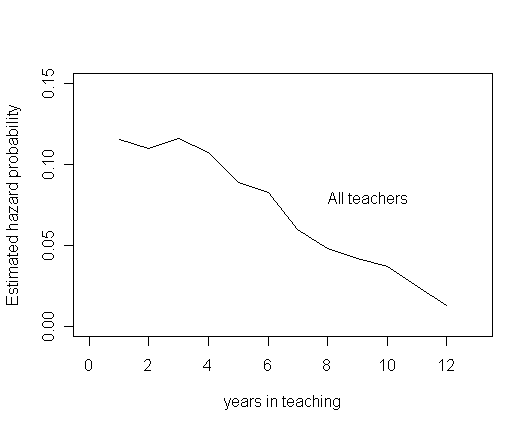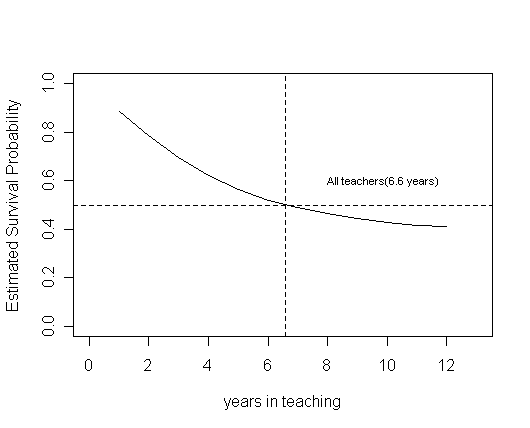R Textbook Examples Applied Longitudinal Data Analysis: Modeling Change and Event Occurrence by Judith D. Singer and John B. Willett Chapter 10: Describing Discrete-time Event Occurrence Data
The examples on the page were written in R version 2.4.1. This page requires package survival.
library(survival)
Table 10.1 on page 327.
teachers<-read.table("https://stats.idre.ucla.edu/stat/examples/alda/teachers.csv", sep=",", header=T)
ts <- survfit( Surv(t, 1-censor)~ 1, conf.type="none", data=teachers)
h<-ts$n.event/ts$n.risk
nlost<-ts$n.risk-ts$n.event- ts$n.risk[-1]
nlost[12] = ts$n.risk[12]-ts$n.event[12]
tab10.1<-cbind(time=ts$time, risk=ts$n.risk, left=ts$n.event, censored=nlost, hazard=h, survival=ts$surv)
tab10.1
time risk left censored hazard survival [1,] 1 3941 456 0 0.11570667 0.8842933 [2,] 2 3485 384 0 0.11018651 0.7868561 [3,] 3 3101 359 0 0.11576911 0.6957625 [4,] 4 2742 295 0 0.10758570 0.6209084 [5,] 5 2447 218 0 0.08908868 0.5655925 [6,] 6 2229 184 0 0.08254823 0.5189038 [7,] 7 2045 123 280 0.06014670 0.4876935 [8,] 8 1642 79 307 0.04811206 0.4642295 [9,] 9 1256 53 255 0.04219745 0.4446402 [10,] 10 948 35 265 0.03691983 0.4282242 [11,] 11 648 16 241 0.02469136 0.4176508 [12,] 12 391 5 386 0.01278772 0.4123100
Figure 10.1, page 333.
plot(ts$time, h, type="l", ylab="Estimated hazard probability", xlab="years in teaching",
ylim=c(0, .15), xlim=c(0, 13))
text(8, .08, "All teachers", adj=0)
plot(ts$time, ts$surv, type="l", ylab="Estimated Survival Probability", xlab="years in teaching",
ylim=c(0, 1.), xlim=c(0, 13))
abline(h=c(.5), lty=2)
abline(v=c(6.6), lty=2)
text(8, .6, "All teachers(6.6 years)", adj=0, cex=.7)
Fig. 10.2, page 340
par(mfrow=c(1, 2), cex=0.7) # Panel A
cocaine<-read.table("https://stats.idre.ucla.edu/stat/examples/alda/cocaine_relapse.csv", sep=",", header=T)
ts <- survfit( Surv(week, 1-censor)~ 1, conf.type="none", data=cocaine)
h<-ts$n.event/ts$n.risk
plot(ts$time, h, type="l", ylab=" ", main="Estimated Hazard Function", xlim=c(0, 13))
plot(ts$time, ts$surv, type="l", ylab=" ", main="Estimated Survival Function", xlim=c(0, 13))
abline(h=c(.5), lty=2)
abline(v=c(7.6), lty=2)
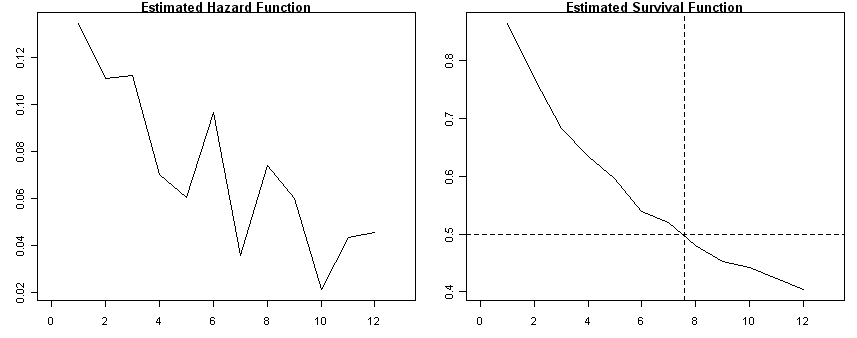
# panel B
firstsex<-read.table("https://stats.idre.ucla.edu/stat/examples/alda/firstsex.csv", sep=",", header=T)
ts <- survfit( Surv(time, 1-censor)~ 1, conf.type="none", data=firstsex)
h<-ts$n.event/ts$n.risk
plot(ts$time, h, type="l", ylab=" ", main="Estimated Hazard Function", xlim=c(6, 13))
plot(ts$time, ts$surv, type="l", ylab=" ", main="Estimated Survival Function", xlim=c(6, 13))
abline(h=c(.5), lty=2)
abline(v=c(10.6), lty=2)
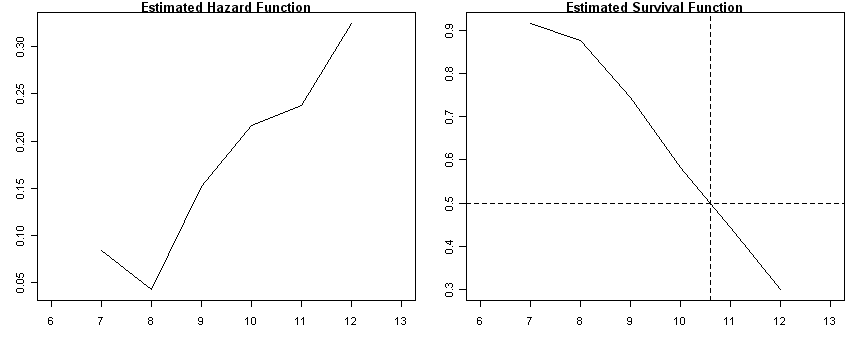
# panel C
rm(list=ls())
suicide<-read.table("https://stats.idre.ucla.edu/stat/examples/alda/suicide.csv", sep=",", header=T)
ts <- survfit( Surv(time, 1-censor)~ 1, conf.type="none", data=suicide)
h<-ts$n.event/ts$n.risk
plot(ts$time, h, type="l", ylab=" ", main="Estimated Hazard Function", xlim=c(4, 24))
plot(ts$time, ts$surv, type="l", ylab=" ", main="Estimated Survival Function", xlim=c(4, 24))
abline(h=c(.5), lty=2)
abline(v=c(14.8), lty=2)
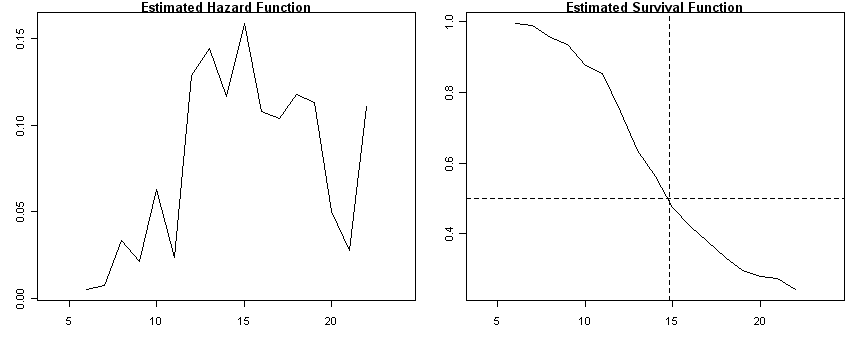
# panel D
congress<-read.table("https://stats.idre.ucla.edu/stat/examples/alda/congress.csv", sep=",", header=T)
ts <- survfit( Surv(time, 1-censor)~ 1, conf.type="none", data=congress)
h<-ts$n.event/ts$n.risk
plot(ts$time, h, type="l", ylab=" ", main="Estimated Hazard Function", xlim=c(0,8))
plot(ts$time, ts$surv, type="l", ylab=" ", main="Estimated Survival Function", xlim=c(0,8))
abline(h=c(.5), lty=2)
abline(v=c(3.5), lty=2)
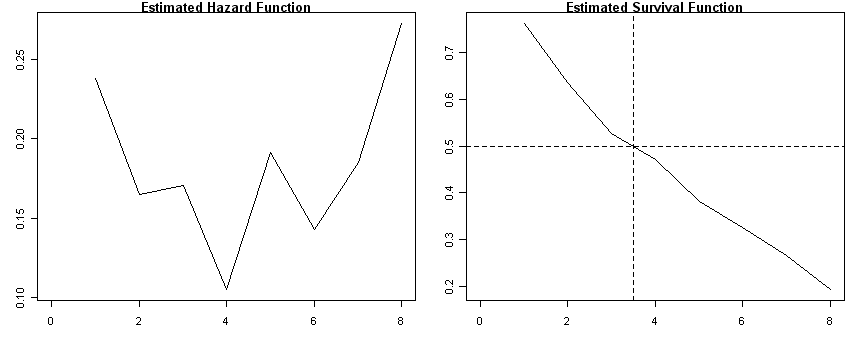
Table 10.2 on page 349. The middle column for the survival function is based on the formula (10.8) on page 350.
rm(list=ls())
teachers<-read.table("https://stats.idre.ucla.edu/stat/examples/alda/teachers.csv", sep=",", header=T)
ts <- summary(survfit( Surv(t, 1-censor)~ 1, conf.type="none", error="greenwood", data=teachers))
h<-ts$n.event/ts$n.risk
se.h<-sqrt(h*(1-h)/ts$n.risk)
s.sqrt<-(ts$std.err)^2/(ts$surv)^2
tab10.2<-cbind(t=ts$time, n=ts$n.risk, hazard = h, se.h, survival=ts$surv, s.sqrt, stderr=ts$std.err)
tab10.2
t n hazard se.h survival s.sqrt stderr [1,] 1 3941 0.11570667 0.005095352 0.8842933 3.320134e-05 0.005095352 [2,] 2 3485 0.11018651 0.005304108 0.7868561 6.873392e-05 0.006523503 [3,] 3 3101 0.11576911 0.005745506 0.6957625 1.109546e-04 0.007328813 [4,] 4 2742 0.10758570 0.005917344 0.6209084 1.549210e-04 0.007728276 [5,] 5 2447 0.08908868 0.005758804 0.5655925 1.948890e-04 0.007895820 [6,] 6 2229 0.08254823 0.005828952 0.5189038 2.352549e-04 0.007958957 [7,] 7 2045 0.06014670 0.005257621 0.4876935 2.665487e-04 0.007962239 [8,] 8 1642 0.04811206 0.005281208 0.4642295 2.973305e-04 0.008004838 [9,] 9 1256 0.04219745 0.005672654 0.4446402 3.324074e-04 0.008106700 [10,] 10 948 0.03691983 0.006124306 0.4282242 3.728453e-04 0.008268668 [11,] 11 648 0.02469136 0.006096155 0.4176508 4.119139e-04 0.008476499 [12,] 12 391 0.01278772 0.005682161 0.4123100 4.450427e-04 0.008698106
Figure 10.4, page 353
Demonstrating the difference between the person-oriented data set teachers and the person-period data set teachers_pp.
teachers<-read.table("https://stats.idre.ucla.edu/stat/examples/alda/teachers.csv", sep=",", header=T)
teachers[teachers$id==20 | teachers$id == 126 | teachers$id ==129, ]
id t censor
19 20 3 0
125 126 12 0
128 129 12 1
To go from person-level/person-oriented data to person-period data, also see our FAQ page.
rm(list=ls())
teachers.pp<-read.table("https://stats.idre.ucla.edu/stat/examples/alda/teachers_pp.csv", sep=",", header=T)
t<-subset(teachers.pp, id %in% c(20, 126, 129))
t
id period event
95 20 1 0
96 20 2 0
97 20 3 1
740 126 1 0
741 126 2 0
742 126 3 0
743 126 4 0
744 126 5 0
745 126 6 0
746 126 7 0
747 126 8 0
748 126 9 0
749 126 10 0
750 126 11 0
751 126 12 1
760 129 1 0
761 129 2 0
762 129 3 0
763 129 4 0
764 129 5 0
765 129 6 0
766 129 7 0
767 129 8 0
768 129 9 0
769 129 10 0
770 129 11 0
771 129 12 0
Table 10.3, page 355
Cross-tabulation of event indicator (event) and time-period indicator (period) in the person-period data set to yield components of the life table.
rm(list=ls())
teachers.pp<-read.table("https://stats.idre.ucla.edu/stat/examples/alda/teachers_pp.csv", sep=",", header=T)
attach(teachers.pp)
temp<-data.frame(table(period, event))
event0<-subset(temp, event==0)
event1<-subset(temp, event==1)
total<-event0$Freq + event1$Freq
proportion<-event1$Freq/total
tab10.3<-cbind(period=event0$period, event0=event0$Freq, event1=event1$Freq, total, proportion)
tab10.3
period event0 event1 total proportion [1,] 1 3485 456 3941 0.11570667 [2,] 2 3101 384 3485 0.11018651 [3,] 3 2742 359 3101 0.11576911 [4,] 4 2447 295 2742 0.10758570 [5,] 5 2229 218 2447 0.08908868 [6,] 6 2045 184 2229 0.08254823 [7,] 7 1922 123 2045 0.06014670 [8,] 8 1563 79 1642 0.04811206 [9,] 9 1203 53 1256 0.04219745 [10,] 10 913 35 948 0.03691983 [11,] 11 632 16 648 0.02469136 [12,] 12 386 5 391 0.01278772

